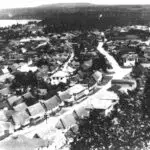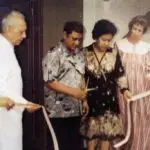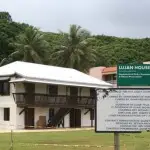Lujan House




Table of Contents
Share This
Old Hagåtña home
The Jose P. Lujan 1911 house in Hagåtña is listed on both the Guam and National Registers of Historic Sites. With so few prewar homes left standing, particularly in Hagåtña, it was important that this structure was restored, according to the Guam Preservation Trust. The two-story structure is located on the corner of Hesler and Padre Palomo Streets.
Lujan, a CHamoru/Chamorro Hagåtña resident, built the house reportedly by hauling the coral stones from Hagåtña Bay. The Spanish-introduced CHamoru method of construction used for this two-story house is mamposteria. Lujan built the house with the intention of renting to US Naval officers who were his first tenants.
Historians speculate that the house was one of the first built in Guam with indoor plumbing. Sometime in the 1920’s, Lujan lived in the house with his new wife for two years while he built them another house in Anigua.
Home of the Guam Institute
For a long period of this building’s life, it housed the Guam Institute, one of the first private schools during Guam’s Naval Era, run by Nieves Flores. Archbishop Felixberto Flores (the first CHamoru archbishop), the first CHamoru Chief Judge Joaquin Perez, Governor Ricardo Bordallo, and other prominent local figures were all students at this school.
The Guam Preservation Trust rehabilitated the structure and retrofitted the upper floor for use as the Trust’s office space and the lower floor to be used by various cultural groups–in keeping with the structure’s use as an institution of learning.
This house is a tangible link to Old Hagåtña. The Trust is recreating the old road that formerly ran right in front of the Lujan House and interpretive signage to tell the story of Old Hagåtña and how Guam’s capital village fell victim to the war, its reoccupation and installation of city streets in a capital village that used to house 9,832 people pre-war (half of the island’s population at the time). The signage reminds people of the out-migration of Hagåtña during World War II and the Post World War II Era.
Rehabilitation completed
The Guam Preservation Trust completed rehabilitation efforts in 2010 of the 1911 Historic Jose P. Lujan house in Hagåtña. It now houses the Trust’s offices.
The Department of Parks and Recreation, Government of Guam, which owns the Lujan House, applied to the Guam Preservation Trust in November 2005 to restore the structure. Several studies were conducted by the Trust before the work was begun. Because this 1911 structure showed obvious earthquake damage on sections of the east wall and had not been maintained for several years, a structural analysis was first conducted by then Duenas, Camacho, Bordallo, and Associates in 2006. The results of this structural analysis were encouraging. Only the upper east wall and a few ifit wood columns could not be salvaged.
Once the structural soundness of this building was established, the Trust contracted Setiadi Architects and its consultant Mason Architects, an internationally recognized restoration architectural firm, to prepare a historic structures report in 2007. This report provided research and information on the structure’s historical background, chronology of use, and existing physical condition. It offered recommendations for proper treatment and directed the 2008 rehabilitation architecture and engineering drawings, which reflected a first floor meeting area and second floor office space.
The Trust successfully managed the construction rehabilitation phase with local contractor JRN from 2008 until 2010. After investing approximately $900,000 towards breathing new life into this house, the Guam Preservation Trust opened its office doors in this beautiful home that Jose P. Lujan built more than 100 years ago.
Due to financial constraints, however, a landscaping plan was not included in the design or construction phases. The Trust is working with the University of Guam’s College of Agriculture to plant ornamentals, fruit trees and many plants that were found along homes in pre World War II Hagåtña such as mango, achote, laguana, donne’, and tobacco.
While the second floor is being used as administrative and management space for the staff of the Guam Preservation Trust, the first floor must be used for advertised Board of Directors public meetings in order to meet Americans with Disabilities Act requirement of being accessible. When not being used by the Board, the first floor can be used by various community organizations throughout the year.
About the structure
The two-story mamposteria structure is approximately 50 feet long, 25 feet wide, and 25 feet tall. The top of the lower floor, or påpa’ såtge, is seven feet tall. The second floor is 10 feet tall at the top of the roof beam, and several more feet taller at the top of the roof hip.
The original construction method of mamposteria and trapechai walls with ifit wood flooring, columns, window shutters, structural columns, and metal roof had seen modifications in its lifetime with the use of Philippine mahogany and incompatible cement.
The rehabilitation work undertaken by the Trust included replacing the entire roof, and replacing the balcony and rotting segments of the floor boards and columns with an ifit species from the Philippines. Unfortunately, Guam does not currently have quantities of mature ifit wood for use as lumber.
The first floor limestone rubble walls, with each wall section about two feet thick, consisted of two parallel walls, filled with sand, shell and rubble. A limestone plaster mix was spread evenly on the wall’s surface. Of all the walls in the Lujan House, only the upper east wall needed to be reconstructed.
The second floor was constructed of limestone and ifit as well but with a different construction method. The limestone walls on the second floor have an infill ifit cross bracing embedded in each wall—serving the same means as contemporary rebar in cement. This method, called trapechai, allows for thinner walls on the second floor, some as thin as seven inches as compared to the two-foot thick walls on the lower floor.
The second floor demolition phase exposed only two original ifit structural columns needing to be replaced.
In the reflected second floor ceiling is evidence of a 1982 collaborative restoration project undertaken by the Lujan family heirs, the Department of Parks and Recreation, and the Guam Women’s Club. This restoration work was overseen by local architects Jack B. Jones, FAIA, and Mark Ruth, AIA. The Philippine mahogany ceiling from this 1982 work was still salvageable and was reused.
The Trust designed and recreated a coral Santa Cruz Street directly in front of the house that used to be there before World War II. The devastation of the Japanese occupation and the severe bombing of historic Hagåtña from the American forces in their efforts to retake Guam left few homes in what was once the most populated village in Guam. Other than the occupation and bombing, the American Naval Administration’s efforts to restore Hagåtña included razing the entire village, bulldozing the debris into Hagåtña Bay and restructuring Hagåtña into city blocks that left land owners with fragmented lots. This restructuring of Hagåtña forced CHamoru’s to relocate to their outlying farm villages and saw the creation of many post World War II villages, such as Dedidu (Dededo), Barigåda (Barrigada), and Yo’ña.
The Lujan House is a testament to one of Guam’s best-known CHamoru builders, designers, and businessmen Jose Pangelinan Lujan.
For further reading
Guam Preservation Trust. “Jose P. Lujan House & Guam Institute: Centennial 1911-2011.” Hagåtña: GPT, 2011.
National Conference of State Historic Preservation Officers. “Guam | NCSHPO.” Directory.
